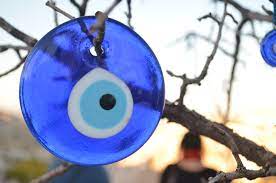The Turkish eye, also known as the lucky eye or the eye of Horus, is a popular amulet in Turkish culture and is believed to have protective properties.
The history of the Turkish eye dates back to ancient Egypt, where the eye of Horus, the god of protection and justice, was believed to have the power to ward off evil and attract good luck. Over time, the symbol of the eye of Horus merged with the beliefs and traditions of other peoples, including the Turks, and became a popular amulet throughout the world.
The design of the Turkish eye is characteristic, with a blue circle in the center that represents the eye, surrounded by a gold or silver ring with a series of stripes that symbolize the tears of the eye. Some Turkish eyes also have a series of white dots around the outer edge, which represent the tears of the eye.
The Turkish eye can be found in a variety of forms, from necklaces and earrings to refrigerator magnets and car ornaments. Many people wear the Turkish eye as a lucky charm, while others use it as a reminder of protection.
In short, the Turkish eye is a popular amulet in Turkish culture with a history dating back to ancient Egypt. It is believed to have protective properties and is used to ward off evil and attract good luck. It can be found in a variety of forms, and is a reminder of protection.

